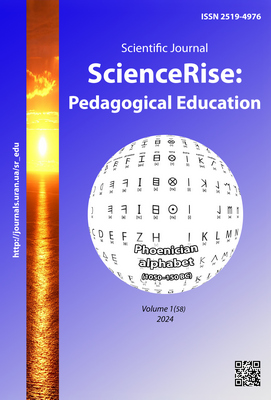Formation of the semiotic component of speech in senior preschool children with logopathology
DOI:
https://doi.org/10.15587/2519-4984.2024.299310Keywords:
semiotic component of speech, children of senior preschool age, speech disorders, logopathologyAbstract
The scientific publication presents a theoretical and experimental-comparative analysis of the formation of the semiotic component of speech in senior preschool children with speech disorders. The purpose of the study is to investigate the dynamics of the development of the semiotic component of speech in senior preschool children with speech pathology after correctional educational and developmental intervention. The methods of the study are: theoretical − analysis of scientific sources to solve the problematic issue; empirical − use of diagnostic tools (tasks − educational, game, research, during which children with speech disorders study phonemic, lexical, grammatical and prosodic levels of speech; analysis; comparison), formative (game, verbal, exercises, etc.) and variable statistical (quantitative and qualitative) ones. Results of the study. Corrective educational and developmental work on the formation of the semiotic component of speech in senior preschool children with speech pathology took place at the propedeutic-foundational (preparing the child for the acquisition of basic speech and language knowledge and skills), variably sequential (providing a combination of visual and speech actions), speech-active (involving the child in the speech environment) stages. Additionally, the methods and techniques of correctional educational and developmental work are substantiated. The compared materials of the study of the ascertaining and formative experiments testified to the dynamics of the development of the semiotic component of speech in children with logopathology. The children studied improved their phonemic (perception, analysis and representation), lexical (expressive and impressive speech), grammatical (composing stories, agreeing verbs with the subject in number, declining nouns and adjectives, modifying verbs by person and number, use diminutives and pet forms of nouns in all genders and cases) and prosodic (normative voice power, speech rate, expressive intonation and clear diction) levels of speech
References
- Bielova, O., Konopliasta, S. (2023). Description of kinesthetic and kinetic motor praxis in older preschool children with logopathology. Pedagogy of Physical Culture and Sports, 27 (5), 386–395. https://doi.org/10.15561/26649837.2023.0505
- Bielova, O., Konopliasta, S. (2023). Functionality of oral and articulatory praxis in older preschool children with logopathology. Child`S Health, 18 (6), 410–416. https://doi.org/10.22141/2224-0551.18.6.2023.1627
- Martynenko, I. V. (2016). State of Communication Activity of Elder Preschool Children with Developmental Language Disorders. International Journal of Pedagogy, Innovation and New Technologies, 3 (1), 68–79. https://doi.org/10.5604/23920092.1207089
- Sobotovych, Ye. F. (2015). Vybrani pratsi z lohopedii. Kyiv: Vydavnychyi dim Dmytra Buraho, 308.
- Pantiuk, T. (2016). Development as an important component of child’s preparation for school. Hirska shkola ukrainskykh Karpat, 14, 105–108.
- Kalmykova, L., Kharchenko, N., Kyuchukov, H., Mysan, I. (2022). The Influence of Speech and Language Competency of Preschoolers on the Success of Further L1 Acquisition and Speech Development at School: Results of a Comparative Psycholinguistic Analysis. Preschool Education: Global Trends, 2, 7–37. https://doi.org/10.31470/2786-703X-2022-2-7-37
- Bazyma, N., Zdanevych, L., Kruty, K., Tsehelnyk, T., Popovych, O., Ivanova, V., Cherepania, N. (2020). Formation of Speech Activity in Older Preschool Children with Autistic Disorders Formation of Speech Activity in Older Preschool Children with Autistic Disorders. BRAIN. Broad research in artificial intelligence and neuroscience, 11 (3), 107–121. https://doi.org/10.18662/brain/11.3/112
- Bielova, O. (2023). Speech of Six-year-old Children with Logopathology: Features and State of Development. Psycholinguistics, 34 (1), 50–84. https://doi.org/10.31470/2309-1797-2023-34-1-50-84
- Bielova, О. (2023). Neuromotor functionality of speech readiness for school in older preschool children with logopathology. Life Span and Disability XXIV, 26 (2), 165–196. https://doi.org/10.57643/lsadj.2023.26.2_07
- Lyndina, Y., Soloviova, T., Tkachenko, L., Bielova, O., Lisova, L., Buhera, Y. (2023). Logopedic Technologies in Work with Children with Special Educational Needs. BRAIN. Broad Research in Artificial Intelligence and Neuroscience, 14 (3), 210–223. https://doi.org/10.18662/brain/14.3/471
- Pakhomova, N., Baranets, I., Okhrimenko, I., Rudenko, L. Stakhova, L., Moroz, L. (2023). Utilizing specializ,ed knowledge during correctional education with older preschool children with speech disor- ders. Revista Conrado, 19 (91), 474–483.
- Ribtsun, Y., Bielova, O., Korolenko, V., Bolotnykova, T., Govorun, O., Myttseva, O. (2023). Personality Development in the Paradigm of Current Neuropedagogy. BRAIN. Broad Research in Artificial Intelligence and Neuroscience, 14 (4), 388–403. https://doi.org/10.18662/brain/14.4/512
- Iuzzini-Seigel, J. (2021). Procedural Learning, Grammar, and Motor Skills in Children With Childhood Apraxia of Speech, Speech Sound Disorder, and Typically Developing Speech. Journal of Speech, Language, and Hearing Research, 64 (4), 1081–1103. https://doi.org/10.1044/2020_jslhr-20-00581
- Klassen, R., Lundquist, B., Westergaard, M. (2022). L1 Grammatical Gender Variation through the Representation in the Lexicon. Journal of Psycholinguistic Research, 52 (2), 359–380. https://doi.org/10.1007/s10936-022-09867-7
- Siemons-Lühring, D. I., Hesping, A. E., Euler, H. A., Meyer, L., Gietmann, C., Suchan, B., Neumann, K. (2023). Spelling Proficiency of Children with a Resolved Phonological Speech Sound Disorder Treated with an Integrated Approach – A Long-Term Follow-Up Randomized Controlled Trial. Children, 10 (7), 1154–1169. https://doi.org/10.3390/children10071154
- Aishwarya, N., Deborah, D. R. (2020). Comparison of Narrative Comprehension and Inference-Making Ability in Native Tamil Speakers in Monolingual and Bilingual Context. Journal of Research in Childhood Education, 35 (4), 616–630. https://doi.org/10.1080/02568543.2020.1810181
Downloads
Published
How to Cite
Issue
Section
License
Copyright (c) 2024 Olena Bielova

This work is licensed under a Creative Commons Attribution 4.0 International License.
Our journal abides by the Creative Commons CC BY copyright rights and permissions for open access journals.
Authors, who are published in this journal, agree to the following conditions:
1. The authors reserve the right to authorship of the work and pass the first publication right of this work to the journal under the terms of a Creative Commons CC BY, which allows others to freely distribute the published research with the obligatory reference to the authors of the original work and the first publication of the work in this journal.
2. The authors have the right to conclude separate supplement agreements that relate to non-exclusive work distribution in the form in which it has been published by the journal (for example, to upload the work to the online storage of the journal or publish it as part of a monograph), provided that the reference to the first publication of the work in this journal is included.








